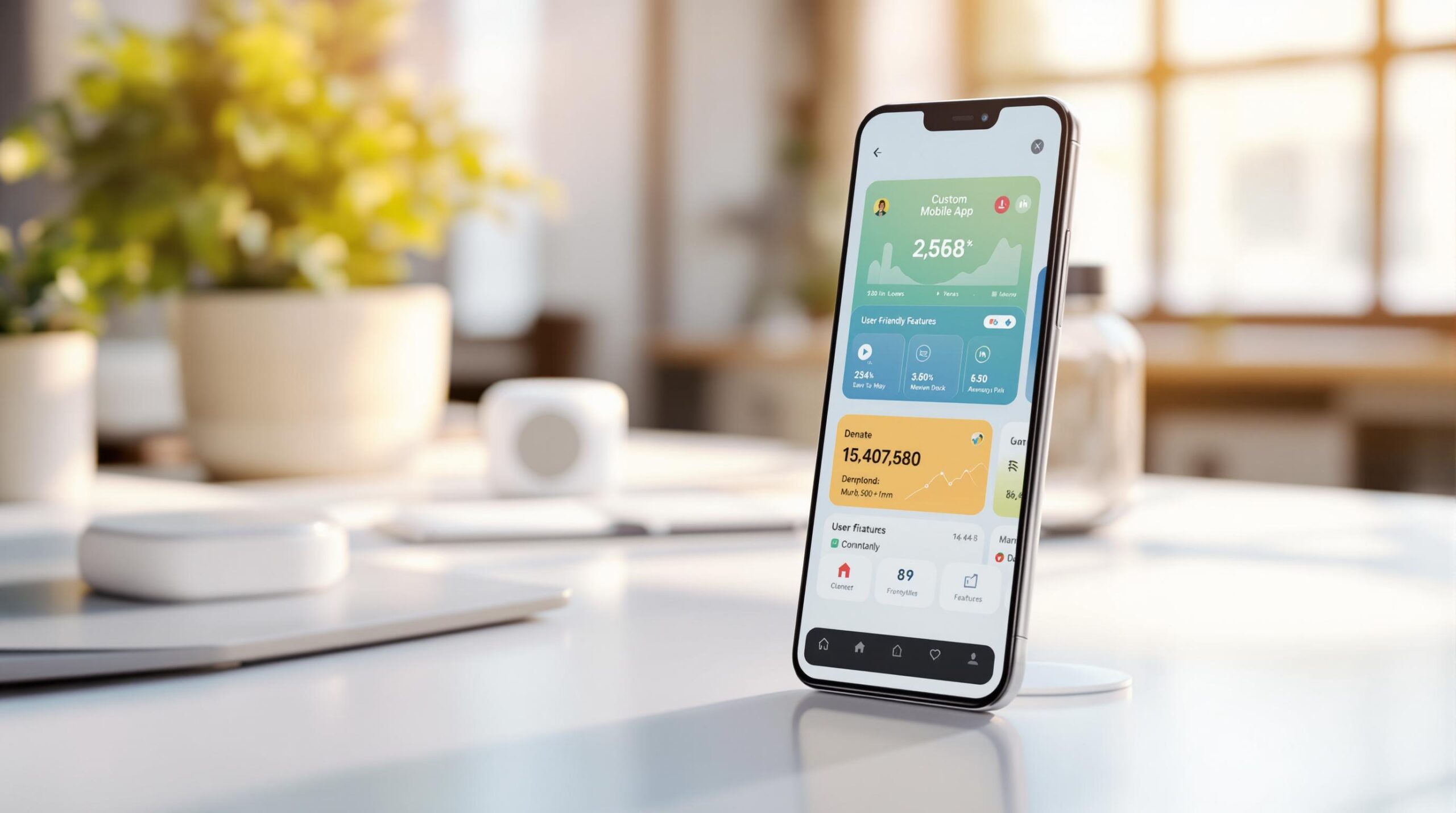
Building a mobile app for your IoT device can transform how users interact with your product. Here’s how to get started:
- Define Clear Goals: Identify the app’s core purpose, user needs (e.g., operators, managers, admins), and technical requirements like connectivity (BLE, Wi-Fi) and security (encryption, authentication).
- Choose the Right Development Stack: Decide between Native (Swift/Kotlin), Cross-Platform (React Native/Flutter), or Hybrid development based on your app’s complexity and budget.
- Integrate IoT Features: Synchronize hardware and software using protocols like BLE or Zigbee. Manage data efficiently with edge computing and cloud integration.
- Focus on User Experience: Design a clear interface with dashboards, control panels, and real-time alerts. Ensure reliable device connections and plan for scalability.
- Test, Launch, and Update: Conduct alpha, beta, and soft launches. Regular updates for security, performance, and features keep your app relevant.
Quick Tip: Secure communication and OTA updates are non-negotiable for IoT apps.
This guide breaks down each step in detail, helping manufacturers create scalable, user-friendly, and secure IoT apps.
VOLO Tech Talks – Mobile App Development for IoT Projects
Set App Goals and Requirements
Defining clear goals and requirements is a key step in building an effective IoT mobile app.
Define the Core Purpose
Your IoT app should have a well-defined primary goal that aligns with your device’s functionality. Focus on these areas:
- Core device functions: Include features like monitoring, control, and data analysis.
- Business objectives: For instance, reducing downtime or improving production processes.
- Integration points: Specify how the app will connect with existing systems.
Understand User Needs
Knowing what users want is critical for your app’s success. For example, the Mind Studios Mulki project found that involving business analysts consistently leads to better user engagement.
Here’s a breakdown of user categories and their access levels:
| User Type | Primary Needs | Access Level |
|---|---|---|
| Operators | Real-time monitoring, basic control | Standard access |
| Managers | Performance analytics, reporting | Advanced access |
| Admins | System configuration, user management | Full access |
| Maintenance | Diagnostic tools, troubleshooting | Technical access |
Outline Technical Requirements
Your app’s technical needs should cover both hardware and software aspects. Key areas to address include:
-
Connectivity Needs
Specify how devices will communicate, such as:- Bluetooth Low Energy (BLE) versions
- Zero-Configuration Networking protocols
- Security measures for data transfer
-
Data Management
Plan how the app will handle data, including:- Real-time data processing
- Storage needs and limitations
- Backup and recovery processes
-
Security Measures
Ensure strong security by implementing:- Authentication for users and devices
- Data encryption
- Secure Over-the-Air (OTA) updates
Once goals and technical requirements are clear, the next step is selecting the right development stack.
Pick Development Stack
Select development tools that ensure your IoT app is secure, efficient, and scalable.
Once you’ve outlined your goals and technical needs, the next step is picking the right development stack tailored to your project.
Choose Platform Type
| Development Type | Benefits | Best For |
|---|---|---|
| Native (Swift/Kotlin) | High performance, direct hardware access | Complex IoT setups, advanced security |
| Cross-platform (React Native/Flutter) | Faster builds, single codebase | Basic device monitoring, simple controls |
| Hybrid | Budget-friendly, quick to launch | Prototyping, simple IoT interfaces |
For projects requiring heavy device communication or real-time data, native development offers the best performance.
"The chosen mobile app tech stack will determine whether your mobile application will be scalable, secure, maintainable, and perform well. It will also directly impact your budget and time-to-market."
Select IoT Tools
Choose backend tools that support effective device management and data processing:
-
Cloud Platforms
AWS IoT Core and Microsoft Azure IoT Hub are top choices, offering scalability and strong security. Azure IoT Hub stands out for its advanced device management and seamless integration with other services. -
Development Frameworks
The LAMP stack works well for flexible, custom solutions, while Nest.js is ideal for more complex backend systems that manage multiple devices.
Plan Security Measures
- Use multi-factor authentication, including biometric options
- Encrypt all communications end-to-end
- Protect APIs with OAuth
- Regularly apply security patches
Validate inputs and run penetration tests frequently. A secure and well-planned stack ensures smooth integration of IoT features and reduces vulnerabilities.
sbb-itb-7af2948
Connect IoT Features
Integrate IoT device functions with efficient hardware synchronization and smart data management.
Sync Hardware and Software
Synchronizing hardware and software effectively starts with selecting the right communication protocol for your devices:
| Protocol | Best Use Case | Power Usage | Range |
|---|---|---|---|
| BLE | Battery-powered devices, small data transfers | Very Low | 30-330 ft |
| Wi-Fi | High-bandwidth data streaming | High | 150-300 ft |
| Zigbee | Mesh networks, smart home devices | Low | 30-65 ft |
| Cellular (4G/5G) | Remote monitoring, mobile devices | Medium-High | Miles |
Real-time updates are crucial for device controls. For instance, if your IoT device manages power settings, the app should instantly show any changes and allow two-way control. Once synchronization is complete, focus on reliable data handling.
Set Up Data Handling
With IoT devices expected to produce 79.4 zettabytes of data by 2025, managing this data efficiently is key. Build a system that includes:
- Edge Computing: Process data locally on devices to minimize delays.
- Cloud Integration: Store data and run advanced analytics using cloud services.
- Data Standardization: Use consistent formats across all devices to simplify operations.
"Effective data management becomes crucial as industries continue to adopt the Internet of Things (IoT) development services. Enterprises face challenges in collecting, processing, and analyzing large data volumes generated by IoT devices." – Webbylab
Test Device Communication
Testing ensures your IoT systems work reliably in real-world conditions.
1. Connection Validation
Check device pairing and unpairing. Verify the app displays device names, icons, and features accurately.
2. State Synchronization
Ensure sensor readings, status updates, and controls are instantly reflected in the app.
3. Error Handling
Prepare for common issues by implementing error-handling measures for:
- Network disruptions
- Low battery
- Devices moving out of range
- Firmware update failures
Include Over-the-Air (OTA) update capabilities for remote fixes and feature updates. This keeps devices secure and functional after deployment.
Stick to standardized protocols and consistent data formats across your IoT system for easier integration and scalability as your network expands. This approach lays the groundwork for long-term success.
Build User Experience
Make sure your app interface is easy to use and devices stay reliably connected.
Design a Clear Interface
Research shows that 74% of users feel frustrated by poorly designed app content. To avoid this, focus on creating an interface that’s straightforward and user-friendly. Key elements to consider include:
| Interface Element | Purpose | Implementation Tips |
|---|---|---|
| Device Dashboard | Quick status overview | Use clear visual indicators for device state |
| Control Panel | Core device functions | Group related controls logically |
| Data Visualization | Performance metrics | Add charts and real-time graphs |
| Alert Center | System notifications | Highlight critical alerts for quick action |
Using consistent design patterns across your app can help users quickly understand how to navigate and use it.
Improve Connection Quality
Reliable connectivity is crucial for a smooth user experience. Here are a few ways to ensure stable connections:
- Optimize access point placement and follow best practices for wireless network design.
- Use strong encryption and access control to secure data transmission.
- Design your network to handle growing capacity and future demands.
A solid network foundation ensures your app can handle increasing device loads without compromising performance.
Plan for Growth
With IoT devices projected to hit 75 billion by 2025, scalability is a must. Here’s how to prepare:
1. Infrastructure Planning
Use cloud services to create a flexible setup that allows for dynamic scaling without huge upfront investments.
2. Performance Optimization
Track app performance and streamline data handling. For instance, Zoom scaled from 10 million to 200 million users in 2020 while maintaining quality.
3. Feature Expansion
Design your app for easy integration of new features using modular architecture, API versioning, and adaptable UI components.
Launch and Update
Launching an IoT app takes thoughtful preparation and consistent maintenance to keep it running smoothly.
Test with Users
Apps that go through beta testing see a 75% boost in retention rates. Here’s how you can structure your testing process:
- Alpha Testing: Check the core functionalities and uncover technical problems.
- Beta Testing: Focus on gathering user feedback and improving the overall experience.
- Soft Launch: Test the app in a limited market to gauge readiness.
Make sure to set up tools like automated crash reporting, in-app feedback systems, and user behavior analytics. These insights will guide both security fixes and feature updates.
Once testing is complete, having a plan for regular updates is key to keeping your app relevant.
Schedule Updates
"Regular mobile app updates are not just a technical nicety but a fundamental necessity. They serve as the pulse that keeps the app vibrant, secure, and aligned with user expectations."
Apps that are updated regularly see retention rates improve by up to four times. Your update strategy should include:
-
Security Patches
Roll out fixes quickly whenever vulnerabilities are found. -
Feature Updates
Release new features on a regular schedule to maintain user interest. -
Performance Optimization
Keep an eye on performance and make improvements as needed. Slow-loading apps drive away 70% of users.
Track Performance
After updates, it’s important to monitor how your app is performing. Pay attention to:
- User retention
- App stability
- How quickly users adopt updates
- Response times
Also, track device connections, data flow, user interactions, server responses, and battery usage. Regular performance reviews will help pinpoint areas for improvement and fine-tune your update plan.
Conclusion
Every step – from setting clear objectives to rolling out updates – plays a key role in creating a successful IoT mobile app. Developing a custom app for your IoT device requires precise skills in hardware integration, security measures, and crafting a seamless user experience.
Strong security measures are the backbone of any reliable IoT app. They safeguard sensitive data and ensure user confidence by providing protection across devices, cloud platforms, and mobile applications.
Key technical skills include BLE integration, Zero-Configuration Networking, IoT cloud connectivity, and expertise in cross-platform development. These are essential for building effective IoT solutions.
Incorporating core IoT features into SDKs establishes a scalable and secure framework. This approach allows developers to focus on enhancing the user experience while ensuring dependable device connectivity – an effective way to grow IoT solutions.

